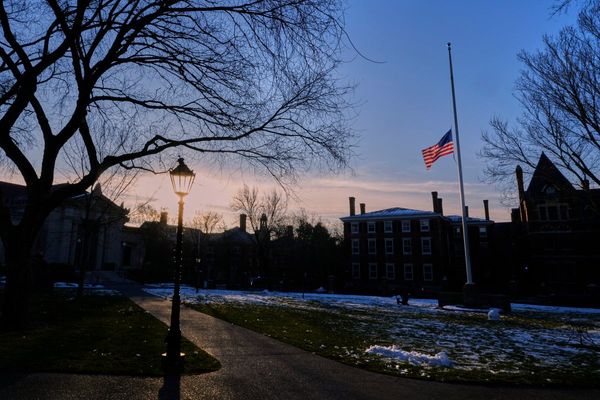
Through the tinny reception on the jail’s phone lines, 29-year-old Adam Bryant told his mom he didn’t want to die.
It was late 2022, and Bryant was incarcerated at Vigo county jail in Terre Haute, Indiana, a city roughly 75 miles west of Indianapolis. Bryant had been arrested for domestic battery on 8 December, and for most of the time between then and the 19 December phone call, he’d been unable to eat without vomiting. He had severe stomach pains, too, which only worsened when he was attacked and beaten. Some of his inmates had heard about his battery charge, and they wanted the ring Bryant was wearing.
“You’re either gonna take care of yourself or they will let you die there,” his mother told him.
Shortly after being attacked by other inmates, Bryant was placed in solitary confinement, where he spent the last five days of his life with minimal human interaction. His condition worsened: he shed more weight, became more fatigued, and even started hallucinating. Video footage shows staff members checking on other inmates while paying little attention to Bryant.
That same video evidence contradicts the jail’s claims that Bryant received his medication and prescribed protein shake on the final day of his life. (Vigo county officials did not respond to questions for this story.)
As the clock approached midnight on Christmas Eve, he sat on the floor of his solitary cell and tried to reach the intercom button that would alert the staff that he needed help. He managed to press it, but most of his attempts were in vain; his arms were simply too weak. Shortly after midnight, he died of hyponatremia – low sodium concentration in the blood.
His death – and the neglect that preceded – is at the center of a new lawsuit, as Bryant’s family sues several employees of the Vigo county jail and sheriff’s office for violating his constitutional rights. His traumatic final days also highlight the cruelty and dangers of solitary confinement or “restrictive housing”, a practice of isolating people that has long been decried by advocates, attorneys and mental health professionals.
The practice became more popular in the US in the 1980s and 1990s, as the prison population soared and overpopulation became more common, leading to a new reliance on isolated units. Now, despite a growing mountain of evidence and repeated reform attempts, the practice continues, creating massive trauma for families across the US.
Matthew Lowen, an associate director of the Vera Institute’s Restoring Promise Initiative, says experts generally agree that somewhere between 75,000 and 80,000 people are locked in solitary confinement in the US on any given day.
But no one knows the exact number, in part because of lax oversight and the many forms of isolation employed by jails and prisons.
“[Solitary confinement] continues to grow in the sense that there’s new facilities that are being built and designed specifically for the use of isolation in near-total cell confinement,” Lowen said.
“But then there’s also sort of the ad hoc or unofficial forms of isolation or solitary confinement lockdowns, where it’s either staff shortages or facility lockdowns for a myriad of reasons, and that could just result in people not being let out of their cells.”
Research indicates solitary confinement is particularly traumatic for people who enter incarceration struggling with their mental health or an addiction.
Bryant was struggling with both. Two days before his 8 December arrest, he asked a therapist for help getting into rehab.
Solitary confinement can often be fatal for people struggling with mental illness, and any amount of time spent in isolated conditions increases the risk of death after release, according to a study by the Jama Network. The study notes that people were 24% more likely to die within their first year out of jail or prison – and 127% more likely to die from an opioid overdose in the first two weeks after release.
“The real abandonment of people with mental health challenges in this country is just a national disgrace,” said Jean Casella, director of the non-profit Solitary Watch. “The people who are unhoused, the people with mental illness who are on the streets, those are the same people who are going to end up in jail eventually in the prison systems eventually. And they are way more likely to land in solitary.”
Casella’s organization was born from the lack of significant oversight of solitary confinement. She and her team have spent years documenting how isolated treatment like what Bryant experienced does not make people safer (including guards and corrections officers).
In many facilities where the use of solitary confinement has been reduced or eliminated, violent incidents have decreased.
Additionally, Casella notes that putting people in isolation presents new roadblocks to one of the purported intents of the criminal justice system: rehabilitation.
“Maintaining contact with family and loved ones has been shown to be one of the most effective ways of not only maintaining sort of order in prison, but also easing people’s transitions and re-entry back into society,” Casella said. “It’s totally destructive to cut off those connections.”
There are also significant roadblocks to reforming this practice. The Biden administration promised reductions in the use of solitary confinement, but Casella says it didn’t create significant change. Biden’s administration poured millions more dollars into studying “restrictive housing”, despite the wealth of studies already in existence. Between 2019 and 2024, the number of people in solitary confinement increased.
Politics has become one of the biggest roadblocks to meaningful reform. Earlier this year, in New York, more than 11,000 New York prison guards launched a strike that, in part, demanded the rollback of the Halt Act, which capped isolation at 15 days and banned its use on vulnerable groups. In response, Governor Kathy Hochul suspended parts of the law for 90 days and deployed the national guard. Advocates condemned the rollback as a dangerous return to the inhumanity of the pre-Halt days, and a judge reversed the rollback on 2 July.
Casella added that, with Trump in office, it was unlikely that significant reforms would happen at the federal level, increasing the importance of state and local battles. She’s hoping to see more reform-minded candidates win those races and push for incarceration models in line with the Scandinavian approach, which promotes education, job training, therapy and mental health support, as well as family visits and reintegration programs.
Organizations like Lowen’s have had success with humane approaches to incarceration.
In 2017, the Vera Institute’s Restoring Promise Initiative partnered with the Connecticut department of correction to transform a unit at Cheshire correctional institution – once a 22-hour lockdown maximum-security facility – into a mentorship-based, dignity-centered space for young adults.
The result: “We eliminated violence on that unit,” said Lowen. Incidents dropped across the prison, showing that training and restorative practices can work.
“The bottom line really is that it doesn’t make people living or working inside prisons or jails any safer,” Lowen said. “It doesn’t make the community safer, and in fact, it could actually contribute to folks being less safe.”
The experts interviewed for this story said Bryant’s case was a clear example of how solitary confinement is often unnecessary and needlessly cruel. On that 19 December phone call with his mother, he asked her not to tell his father about what he was experiencing. She told him she wouldn’t, then she encouraged him to stay strong.
“Oh Adam, I’m so sorry,” she said, fighting back tears. “I love you.”
“I love you, too,” he said before hanging up.







